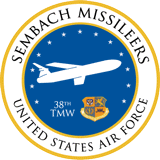A replacement for the TM-61A Matador, the Mace was a tactical surface-launched missile designed to destroy ground targets. Initially designated the TM-76, then the MGM-13, and finally the CGM-13B, the Mace could be launched from either a mobile trailer or a bomb-proof shelter. Like the Matador, a booster rocket launched the Mace, and a jet engine propelled it to the target.
Development of the Mace began in 1954, and the first test firing occurred in 1956. The first version of the Mace, the “A,” employed a terrain-matching radar guidance system known as ATRAN (Automatic Terrain Recognition And Navigation) which matched the return from a radar scanning antenna was matched with a series of onboard radar terrain “maps.” The guidance system corrected the flight path if it deviated from the maps. In the spring of 1959 the U.S. Air Force deployed the “A” version in Europe, and they remained in service until the mid-1960s. Afterward, some became target drones because their size and performance characteristics resembled those of a manned aircraft.
Development of the “B” model began in 1959. In addition to having a jam-proof inertial guidance system, the CGM-13B had twice the range of the earlier version. Initial deployments of the CGM-13B to operational units started in 1961, and they remained operational in Europe and the Pacific until the early 1970s.
TECHNICAL NOTES:
Armament: Conventional or nuclear warhead (1.1 MT)
Engine: Allison J33 of 5,200 lbs. thrust; Thiokol solid-propellant booster rocket of 100,000 lbs. thrust
Maximum speed: 650 mph in level flight; supersonic in final dive
Range: Mace-A 800 miles; Mace-B 1,400 miles
Span: 22 ft. 11 in.
Length: 44 ft. 6 in.
Height: 9 ft. 7 in.
Weight: 18,000 lbs.
Source: National Museum of the USAF
Additional Martin TM-76/MGM-13/CGM-13 Mace information can be found at The Martin Matador and Mace Missiles.

